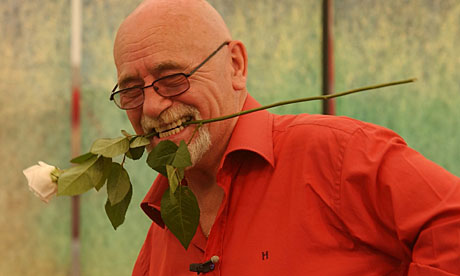
"Cluny was a God of War! Cluny was coming nearer!" "I – am that is!" Logalogalogalogalog. The Guosim – or Guerrilla Union of Shrews in Mossflower. If the quality of children's literature can be measured by memories retained 20 years after reading, then Brian Jacques is up there with the very best.
I went through a long-ish phase when anthropomorphic animals were all I desired in my reading material. Dick King-Smith was clearly leader of the pack, but Colin Dann's The Animals of Farthing Wood and its sequels made me very happy, as did William Horwood and Duncton Wood, Robin Jarvis and his Deptford Mice and Barbara Sleigh and the excellent Carbonel books. But it was Jacques's Redwall stories which made the greatest mark – and learning of Jacques's death this week cast me right back to my 10-year-old self and my obsessive gulping down of the adventures of his Abbey-dwelling mice and their friends.
I started, as did Jacques, with Redwall: the quest of young mouse Matthias to find the mythical sword of (mouse) Martin the Warrior and save Redwall Abbey from Cluny and his nasty rats. Then came Mossflower – Martin's own quest to rescue the inhabitants of Mossflower from the evil rule of the wildcat tyrant Tsarmina. Mattimeo, in which Matthias's son is kidnapped by the slaver fox Slagar, was also a favourite, reread relentlessly.
I loved the characters – Basil Stag Hare, the hare who really wants to be a stag, and Warbeak the Sparra Warrior were particular favourites. I loved the puzzles that the characters would have to work out to complete their quests ... how excited I was to discover what "I – am that is" meant. I liked the books so much I read the author biography – the first time I'd wanted to know more about the author of a novel – and I can still remember being intrigued by the fact that Jacques had been a truck driver in a former life (more details in Julia Eccleshare's lovely obituary). And I adored the mouthwatering feasts the Redwall gang would indulge in. Here's a taster, from Mossflower:
"Bulrush and water-shrimp soup provided by the otters; a large flagon of Skipper's famous hot root punch; hazelnut truffle; blackberry apple crumble; baked sweet chestnuts; honeyed toffee pears; and maple tree cordial, a joint effort by hedgehogs and squirrels. The Loamhedge and Mossflower mice had combined to provide a number of currant and berry pies, seedcake and potato scones and a cask of October ale. By far the biggest single offering was a colossal turnip'n'tater'n'beetroot'n'bean deeper'n'ever pie with tomato chutney baked by the Foremole and his team."
Or Goody Stickle (can you guess what kind of animal she is?) and her "oat and honey scones, piping hot and oozing butter, or her apple and blackberry pudding with spices and fresh cream, or just her new yellow cheese with hot oven bread and a stick of fresh celery ... " Mmm. It strikes me now that much of this would be somewhat difficult for mice to digest, but still: tasty.
I did read Jacques's fourth novel, Mariel of Redwall, but either I was growing out of talking animals by then or it just wasn't as good (I suspect a bit of both), and I moved on to other things (was it a Diana Wynne Jones\ phase that followed? I think so.) Rereading the Redwall books as an adult in a bout of nostalgia a few years back, they weren't quite what I remembered: the prose was a bit too flowery, and the relative sizes of the animals, easily overlooked as a child, were just too ridiculous as an adult. A badger could easily take out a gang of rats, even the deadly hordes of Cluny the Scourge, for goodness sake. Mice could never see off a wildcat and nor would they stand a chance against a fox, even with mythical swords and help from squirrels.
But I remember my Redwall trilogy with enormous affection, as I'm sure many of the 20 million people who've also bought Jacques's books do too, and I'll be digging out my battered copies in his honour next time I'm back at my parents'. Eulalia!

